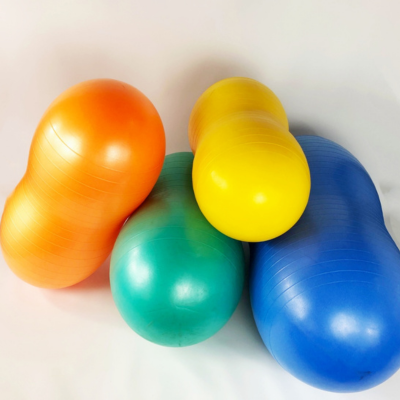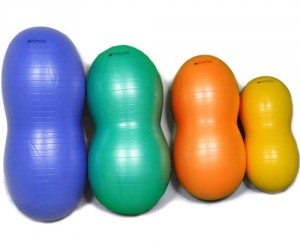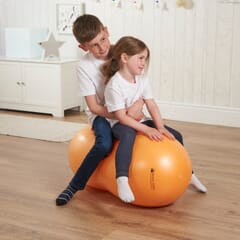Get exclusive deals you won't find anywhere else straight to your inbox.

The Benefits Of Peanut Therapy Balls
The Benefits of Peanut Therapy Balls
The benefits of peanut therapy balls are widely acknowledged for children and adults with a range of abilities.
Balls are used for balance and co-ordination training, strengthening, gross motor and proprioceptive activities.
Balls are commonly used for:
- Improving dynamic balance by sitting or lying on top of the ball
- Activities to facilitate movement and general gross motor coordination
- Exercises to increase core strength by working on the abdomen and back control
- Sensory activities such as applying deep pressure with the ball to calm
- Gradual introduction of increased weight bearing activities to improve muscle tone and strength
- Games and fun activities to improve cognitive skills and encourage cooperation
The traditional round therapy ball works well for all of these activities.
However, some users, particularly children, may find the instability of the round ball too challenging.
For these users the Peanut Ball is an ideal way to harness the benefits of ball therapy in a less intimidating manner.
This allows them to work and build confidence as they develop.
What Is A Peanut Ball?
A Peanut Ball is an inflatable therapy ball with all the benefits of a traditional therapy ball.
The peanut ball is effectively two therapy balls joined in the middle by a saddle which is set slightly lower than the two ends.
This makes the Peanut Ball more stable than a traditional ball allowing users of all ages and abilities to use the ball with confidence.
The most stable part of the ball is the middle “saddle”.
The user sit can sit here or with their legs either side of the ball for stability and security – giving confidence.
The peanut ball can be used for proprioceptive activities for those with poor body awareness.
The shape allows the therapist to share the ball where necessary (for example to give a child extra support and confidence on the ball).
A traditional round ball can roll is any direction which can be too unpredicatable for some.
The shape of the peanut ball effectively means it can only roll in one direction.
This allows balance and strengthening work to be performed but in a more predictable and safer way.
This allows clients of every age and most diagnoses to benefit from ball therapy. The shape of the
Our balls are CE tested and are manufactured in compliance with 93/42/EEC class 1 medical device specifications.
Sizing
We have laid out some basic guidelines below. However, we recommend that you consult with an occupational therapist or physio with regards to the sizing of your ideal ball.
- With the user straddling the ball on the centre saddle, their weight is evenly distributed and feet are flat on the ground.
- Ideally the knees should be level with the pelvis creating a 90-degree angle at both the hips and the knees with the user’s thighs parallel to the ground.
- The head, shoulder and pelvis of the user should be in a vertical line, with no leaning necessary to act as a counter balance to keep them on the ball.
The ball can be inflated and deflated slightly to adjust the height.
The ball should be firm enough to sit on and should not exceed the maximum recommended size.
A fully inflated ball will compress less and will therefore be less stable.
This makes some exercises harder as the ball will tend to roll more easily.
Letting a little air out will make increase the rolling resistance giving it more stability.
As a quick guide before buying a ball, measure the distance from the user’s armpit to the middle finger tip.
Match this measurement to the height of the ball (within 5cm).
This is a good starting point and once you have purchased your ball and inflated it you can follow steps 1 to 3 to ensure you have the correct ball size.
We are happy to exchange your ball for a bigger or smaller size if necessary.
User Weight
Height is the biggest factor to take into consideration when choosing a therapy ball.
However the users weight should also be taken into account.
Someone with a weight-to-height ratio higher than average will cause the ball to compress more when they sit on the ball.
This means the 90 degree angle at hip and knee may not be achievable.
These users should consider purchasing the next size up.
Adjusting the amount of air in the peanut ball will affect the size of the ball and the compression when the user sits on it.
Inflate or deflate the ball slightly to achieve the required 90 degree angle at hip and knee.
It should be noted that too little air in the ball can stabilise it too much making balancing exercises too easy and less effective.
Too much air pressure could make these exercises too difficult as the ball will roll more.
Weight limit
The recommended maximum user weight for Sensory Direct peanut balls is 20 stone or 130kg




